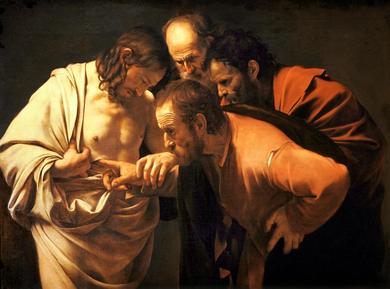|
4/26/2019 0 Comments Article III - The ResurrectionPost-Mortem Appearances of JesusIn the previous post, we saw the indisputable historical evidence for the empty tomb. The empty tomb, of course, does not prove the bodily Resurrection of Jesus, but it is an important fact. The second historical fact is the appearances of Jesus after his death or his post-mortem appearances. We have multiple independent reports of these appearances, as with the empty tomb, which gives us confidence. We find the primary account in Paul's first letter to the Corinthians, chapter 15: "For I delivered to you as of first importance what I also received, that Christ died for our sins in accordance with the Scriptures, that he was buried, that he was raised on the third day in accordance with the Scriptures, and that he appeared to Cephas, then to the Twelve. Then he appeared to more than five hundred brethren at one time, most of whom are still alive, though some have fallen asleep. Then he appeared to James, then to all the apostles. Last of all, as to one untimely born, he appeared also to me (1 Cor 15:3–8)." Scholars date this passage to within 5-10 years of the resurrection appearances (see the previous post for more information). Paul gives it even more credibility when he says, "Then he appeared to more than five hundred brethren at one time, most of whom are still alive..." (1 Cor 15:6). Paul suggests that if you don't believe him ask one of the five hundred who saw him risen because most of them are still alive. If the event had never taken place and therefore no eyewitnesses, then Paul would not have challenged the people to speak with them. Evidently, there were many still alive, and Paul issues the challenge to those who doubt. Paul mentions the other appearances to Peter and the disciples, which are also well attested. We have multiple independent accounts of each of these encounters (see below for a list of appearances). Finally, Jesus appears to James and Paul, two people not inclined to think Jesus rose from the dead. James was a relative of Jesus and deeply skeptical of him. James is the cousin of Jesus, the son of Mary, the wife of Clopas who was the Virgin Mary's close relative. We have good evidence from the gospels that during Jesus' lifetime James was skeptical of Jesus and did not come to believe in him until after his death and resurrection (see https://youtu.be/_A-p38y9cjU and https://www.reasonablefaith.org/writings/popular-writings/jesus-of-nazareth/the-resurrection-of-jesus/). Saul who later became Paul was an enemy of Christians and participated in their murder (1 Tim 1:13; Acts 7:58, 22:6-21; Gal 1:11-24). It is hard to believe that either James or Paul would sincerely claim that Jesus has appeared to them bodily unless that is what actually happened. The post-mortem Resurrection appearances of Jesus is the second fact on which a majority of scholars and historians agree. We are confident from a historical perspective that several people, from various walks of life, had an encounter with the risen Jesus (bodily) after his death. We gather these facts from multiple historically reliable accounts, but at this point, we have not attempted to explain the evidence, right now we are still collecting it. The next post will cover our third historical fact: the sudden and surprising birth of Christianity. The resurrection appearances of Jesus Christ on the third day
To Mary Magdalene (Jn 20:10-18 See also Mk 16:9-11) To the women at the tomb (Mt 28:1-10 pp Mk 16:1-8 pp Lk 24:1-12) To Peter (Lk 24:34; 1Co 15:5) To the two travellers to Emmaus (Mk 16:12-13; Lk 24:13-16,30-32) To the disciples in the upper room (Mk 16:14 pp Lk 24:36 pp Jn 20:19) Further appearances of Jesus Christ To the disciples in the upper room (See also Jn 20:26; 1Co 15:5) Other appearances (Jn 21:1 See also Mt 28:16-17; 1Co 15:6-7) Jesus Christ appears at his ascension (Mk 16:19; Lk 24:50-51; Ac 1:9) Martin H. Manser, Dictionary of Bible Themes: The Accessible and Comprehensive Tool for Topical Studies (London: Martin Manser, 2009).
0 Comments
Leave a Reply. |
AuthorI am a Catholic priest writing about Catholic things. Archives
May 2019
CategoriesAll Advent Almsgiving Ash Wednesday Catholic Charity Christmas Confession Discipleship Divine Mercy Eternal Life Explaining Facts Faith God Greatest Story History Holiness Holy Mass Hope Jacques Philippe Jesus Kingdom Of God Lent Lord Love Lust Nativity Of The Lord O Antiphons Pope Benedict XVI Prayer Resurrection Of Jesus Spiritual Life St. Faustina St. John Paul II St. Thomas Aquinas Temptations Temptations Of Jesus Trust Year Of Mercy |

 RSS Feed
RSS Feed